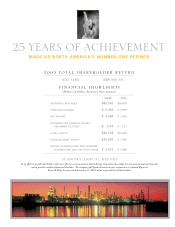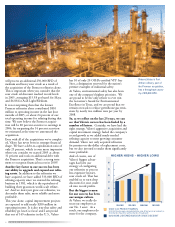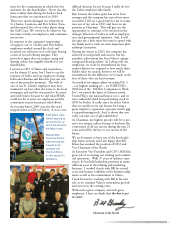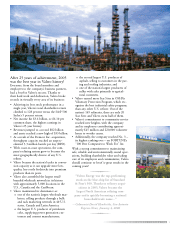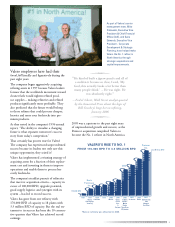Valero 2005 Annual Report Download - page 6
Download and view the complete annual report
Please find page 6 of the 2005 Valero annual report below. You can navigate through the pages in the report by either clicking on the pages listed below, or by using the keyword search tool below to find specific information within the annual report.
4 VA L E R O E N E R G Y C O R P OR A T I O N
will process an additional 250,000 BPD of
medium and heavy sour crude as a result of
the acquisition of the Premcor refineries alone.
This is important when you consider that the
sour crude oil discount reached record levels
in 2005, averaging $15.58 per barrel for Maya
and $6.88 for Arab Light/Medium.
It is not surprising then that the former
Premcor refineries alone contributed $810
million to operating income in the last four
months of 2005, or about 24 percent of our
total operating income for refining during that
time. We now believe the Premcor acquisi-
tion will be 20 percent accretive to earnings in
2006, far surpassing the 14 percent accretion
we estimated at the time we announced the
acquisition.
Even with all of the acquisitions we’ve complet-
ed, Valero has never been in stronger financial
shape. We have a debt-to-capitalization ratio of
only 25 percent, which is even more impressive
when you consider we started 2005 at about
31 percent and took on additional debt with
the Premcor acquisition. That’s a strong testa-
ment to our great financial success in 2005!
Another key factor to our success has been
our ability to upgrade and expand our refin-
ing assets. In addition to the refineries we
have acquired, we have added 533,000 BPD of
refining capacity since we entered the refining
business in 1981, which is the equivalent of
building three grassroots world-scale refiner-
ies! And we don’t just grow our refineries, we
also make them safer, more reliable and more
profitable.
This year alone, capital improvement projects
are expected to add nearly $200 million in
operating income. It is also true that safety and
reliability go hand-in-hand, and I am proud
that out of 149 refineries in the U.S., Valero
has 10 of only 20 OSHA-certified VPP Star
Sites, a designation reserved for the nation’s
premier examples of industrial safety.
At Valero, environmental safety has also been
one of the company’s highest priorities. We
are proud to be the only refiner to ever win
the Governor’s Award for Environmental
Excellence in Texas, and we are proud that we
remain on track to reduce greenhouse gas emis-
sions by nearly two million tons per year by
2008.
So, as we reflect on the last 25 years, we can
see that Valero’s success has been fueled by a
number of factors. Certainly, we have had the
right strategy. Valero’s aggressive acquisition and
capital investment strategy fueled the company’s
record growth as we added much-needed
refining capacity to meet growing consumer
demand. Valero not only acquired refineries
for pennies-on-the-dollar of replacement costs,
but we also invested to make them significantly
more profitable.
And of course, one of
Valero’s biggest advan-
tages has been our
strategy of configuring
our refineries to process
less-expensive heavier,
sour crude oil. That has
enabled us to turn deep
discounts for sour crude
oil into record profits.
But the biggest reason
for our success has been
our unique culture.
At Valero, we really do
treat our employees as
our No. 1 asset. As a
result, our employees do
more for the company,
HIGHER HIGHS • HIGHER LOWS
USGC 5-3-2 PRODUCT MARGIN
(U.S. Gulf Coast margin calculated with the ratio of five barrels of crude oil vs.
three barrels of gasoline and two barrels of heating oil)
50/50 ARAB LIGHT/MEDIUM SOUR CRUDE DISCOUNT
1998-2002
$6
1999-2003 2000-2004 2001-2005
0
$5
$4
$3
$2
$1
[Above] Valero’s Port
Arthur refinery, part of
the Premcor acquisition,
has a throughput capac-
ity of 295,000 BPD.



